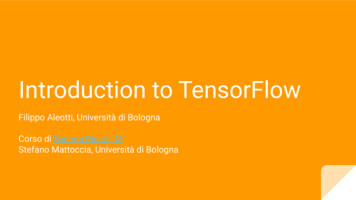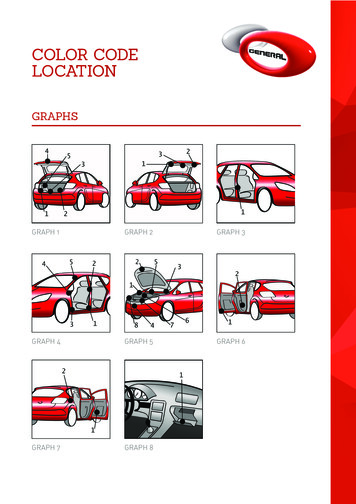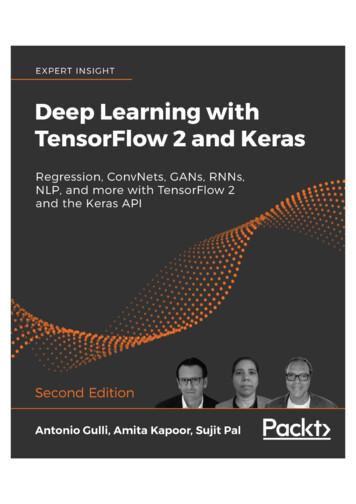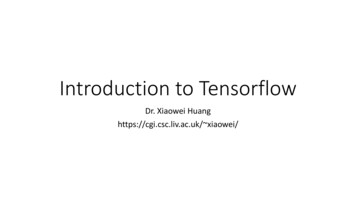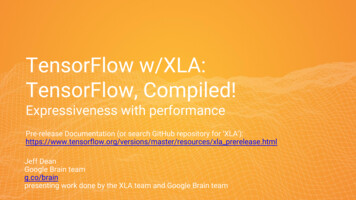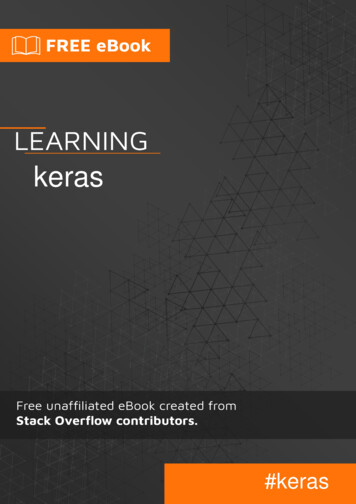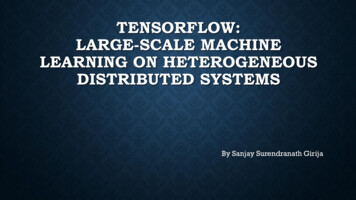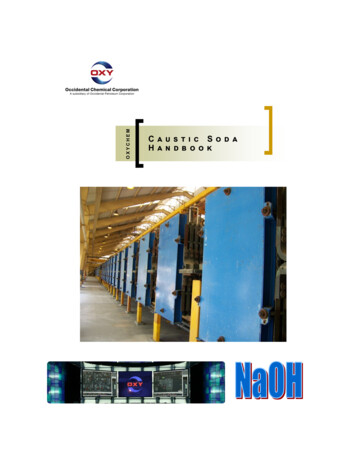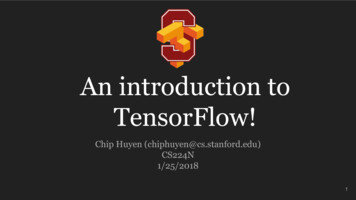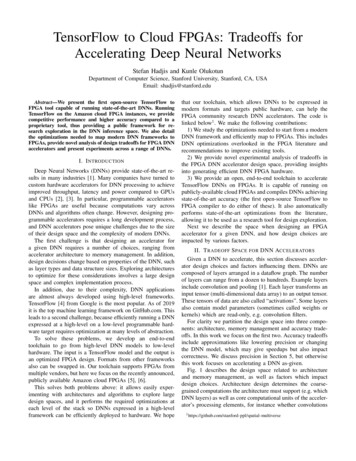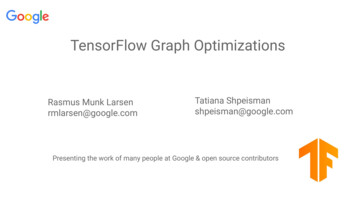
Transcription
TensorFlow Graph OptimizationsRasmus Munk Larsenrmlarsen@google.comTatiana Shpeismanshpeisman@google.comPresenting the work of many people at Google & open source contributors
TensorFlow
Open, standard software forgeneral machine learningGreat for Deep Learning inparticularhttp://tensorflow.org/andFirst released Nov 2015Apache 2.0 ers many Google products
TensorFlow Graph concepts TensorFlow (v1.x) programs generate a DataFlow (directed, multi-) Graph Device independent intermediate program representation TensorFlow v2.x uses a mix of imperative (Eager) execution mode andgraphs functions Graph nodes represent operations “Ops” (Add, MatMul, Conv2D, ) Abstract device-, execution backend-, and language independent API Implemented by Op Kernels written in C , specialized on Type, Device Graph edges represent “data” flowing between ops Tensors (ref-counted, n-dimensional array buffers in device memory) Control dependencies: A- B means A must finish before B can run Resource handles to state (e.g. variables, input data pipelines)
Graph example: The Inception Architecture (2014)Going Deeper with ConvolutionsChristian Szegedy, Wei Liu, Yangqing Jia, Pierre Sermanet, Scott Reed, Dragomir Anguelov,Dumitru Erhan, Vincent Vanhoucke, Andrew RabinovichArXiv 2014, CVPR 2015
Graph example: The TransformerAttention Is All You Need (arXiv 2017)Ashish Vaswani, Noam Shazeer, Niki Parmar, JakobUszkoreit, Llion Jones, Aidan N. Gomez, Lukasz Kaiser,Illia Polosukhin
Grappler
Grappler: Grappling with TF Graphs Grappler: Default graph optimization system in the TF runtime Re-writes graphs to improve out-of-the-box TensorFlow performance Provides a plugin infrastructure to register custom optimizers/rewritersMain goals: Automatically improve TF performance through graph simplifications &high-level optimizations that benefit most target HW architectures(CPU/GPU/TPU/mobile etc.) Reduce device peak memory usage to enable larger models to run Improve hardware utilization by optimizing the mapping of graph nodesto compute resourcesProvides cost models to drive optimization and help diagnose modelperformance
Grappler: TensorFlow ContextPythonSwiftJava.C GraphGrapplerXLA CompilerHLOLLOTPULLVM ascript WebGL.TF runtimeexecutorGPU/CPU
Why transformations at the graph level? Pros: Many optimizations can be easier to discover and express as high-level graph transformations Example: Matmul(Transpose(x), y) Matmul(x,y, transpose x True)Graph is backend independent (TF runtime, XLA, TensorRT, TensorFlow.js, .)Interoperable with TensorFlow supported languages (protocol buffer format)Optimizations can be applied at runtime or offline using our standalone toolLots of existing models (TF Hub, Google production models) available for learningPragmatic: Helps the most existing TensorFlow users get better “out-of-the-box” performanceCons: Rewrites can be tricky to implement correctly, because of loosely defined graph semantics In-place ops, side-effects, control flow, control dependenciesProtocol buffer dependence increases binary sizeCurrently requires extra graph format conversions in TF runtime
Examples of Graph Simplifications Graph minimization and canonicalization Redundant computation removal through constant folding, CSE, redundant control edgeremoval by transitive reduction on graph Whole graph analysis to identify and remove hidden identity and other unnecessary ops (e.g.shuffling a Tensor of size 1 or reductions along empty set of dimensions are identity ops)Algebraic simplifications Take advantage of commutativity, associativity, and distributivity to simplify computations Example: A 2*B 2*C Identity(A) 2*A 2*B 2*C 2*AddN(A,B,C) Synergy: Each optimization builds upon the previous ones Graph optimizers at er/tensorflow/core/grappler/optimizers
Graph SimplificationsAbstractInterpretationS tf.shape(A)B tf.ones(S)SimplificationsS tf.constant([2,2])B tf.constant([[1,1],[1,1]])S [2,2]MaterializationS tf.constant([2,2])B tf.ones(S)
MetaOptimizer Top-level driver invoked by runtime or standalone toolControlled by RewriterConfig in TF Config Runs multiple sub-optimizers in a loop: (* not on by default):i 0while i config.meta optimizer iterations (default 2):Pruning()# Remove nodes not in fanin of outputs, unused functionsFunction()# Function specialization & inlining, symbolic gradient inliningDebugStripper ()* # Remove assert, print, check numericsConstFold ()# Constant folding and materializationShape()# Symbolic shape arithmeticRemapper()# Op fusionArithmetic ()# Node deduping (CSE) & arithmetic simplificationif i 0: Layout() # Layout optimization for GPUif i 0: Memory() # Swap-out/Swap-in, Recompute*, split large nodesLoop()# Loop Invariant Node Motion*, Stack Push & Dead Node EliminationDependency ()# Prune/optimize control edges, NoOp/Identity node pruningCustom()# Run registered custom optimizers (e.g. TensorRT)i 1
Constant folding optimizerdo:InferShapesStatically() # Fixed-point iteration with symbolic shapesgraph changed MaterializeConstants() # grad broadcast, reduction dimsq NodesWithKnownInputs()while not q.empty():node q.pop()graph changed FoldGraph(node, &q) # Evaluate node on hostgraph changed SimplifyGraph()while graph changed
Constant folding optimizer: SimplifyGraph() Removes trivial ops, e.g. identity Reshape, Transpose of 1-d tensors, Slice(x) x, etc.Rewrites that enable further constant folding, e.g. Constant propagation through Enter Switch(pred x, value x) propagate False through port0, True through port1 Partial constant propagation through IdentityNArithmetic rewrites that rely on known shapes or inputs, e.g. Constant push-down: Add(c1, Add(x, c2)) Add(x, c1 c2) ConvND(c1 * x, c2) ConvND(x, c1 * c2) Partial constfold: AddN(c1, x, c2, y) AddN(c1 c2, x, y), Concat([x, c1, c2, y]) Concat([x, Concat([c1, c2]), y) Operations with neutral & absorbing elements: x * Ones(s) Identity(x), if shape(x) output shape x * Ones(s) BroadcastTo(x, Shape(s)), if shape(s) output shape Same for x Zeros(s) , x / Ones(s), x * Zeros(s) etc. Zeros(s) - y Neg(y), if shape(y) output shape Ones(s) / y Recip(y) if shape(y) output shape
Arithmetic optimizer1.2.Node deduplication (common subexpression elimination)Arithmetic simplifications & optimizationsDedupComputations():do:stop trueUniqueNodes repsfor node in graph.nodes():rep reps. FindOrInsert (node, IsCommutative (node))if rep node or !SafeToDedup (node, rep):continuefor fanout in node.fanout():ReplaceInputs (fanout, node, rep)stop falsewhile !stop
Arithmetic optimizer: Arithmetic simplifications Broadcast minimization Matmul(Transpose(x), y) Matmul(x, y, transpose x True)Remove redundant ops or op pairs Example: (matrix1 scalar1) (matrix2 scalar2) (matrix1 matrix2) (scalar1 scalar2)Better use of intrinsics Flattening: a b c d AddN(a, b, c, d)Hoisting: AddN(x * a, b * x, x * c) x * AddN(a b c)Simplification to reduce number of nodes: Numeric: x x x 3*x Logic: !(x y) x yTranspose(Transpose(x, perm), inverse perm)BitCast(BitCast(x, dtype1), dtype2) BitCast(x, dtype2)Pairs of elementwise involutions f(f(x)) x (Neg, Conj, Reciprocal, LogicalNot)Repeated Idempotent ops f(f(x)) f(x) (DeepCopy, Identity, CheckNumerics.)Hoist chains of unary ops at Concat/Split/SplitV Concat([Exp(Cos(x)), Exp(Cos(y)), Exp(Cos(z))]) Exp(Cos(Concat([x, y, z])))[Exp(Cos(y)) for y in Split(x)] Split(Exp(Cos(x), num splits)
Layout optimizer
Layout optimizerExample: Original graph with all ops in NHWC eReluBiasAddGrad
Layout optimizerPhase 1: Expand by inserting conversion pairsNHWC to NCHWNCHW to ReshapeReluBiasAddGrad
Layout optimizerPhase 2: Collapse adjacent conversion pairsNHWC to NCHWNCHW to ReshapeReluBiasAddGrad
Remapper optimizer: Op fusion Replaces commonly occurring subgraphs with optimized fused “monolithic” kernels Examples of patterns fused: Conv2D BiasAdd Activation Conv2D FusedBatchNorm Activation Conv2D Squeeze BiasAdd MatMul BiasAdd Activation Fusing ops together provides several performance advantages: Completely eliminates Op scheduling overhead (big win for cheap ops) Increases opportunities for ILP, vectorization etc. Improves temporal and spatial locality of data access E.g. MatMul is computed block-wise and bias and activation function can beapplied while data is still “hot” in cache. A separate mechanism allows the TensorFlow compiler to cluster subgraphs and generatefused kernel code on-the-fly
Memory optimizer Memory optimization based on abstract interpretation Swap-out / Swap-in optimization Reduces device memory usage by swapping to host memory Uses memory cost model to estimate peak memory Uses op cost model to schedule Swap-In at (roughly) the right time Enables models for Waymo, Cerebra mobilenetRecomputation optimization (not on by default) Rewrites large aggregation nodes to fit in device memory Allocator constraint relaxation Fixes 2x memory peak bug and removes explicit copy in AssignOpAdds more opportunities for buffer forwarding in TF runtime
Peak Memory tedNot YetExecutedConvGradBatchNormTcConv2DApproach: keep track of tensorallocation and deallocation duringsimulation
p OutConv2DSwap In
mTcConv2DConvGrad
Control Flow Optimizer Loop Invariant Node Motion Contributed by Alibaba TensorFlow teamHoists loop-invariant subgraphs out of loopsNot enabled by defaultStackPush removal Remove StackPushes without consumers No matching StackPop or matching StackPop with noconsumers Dead Branch Elimination for Switch with constantpredicate Deduce loop trip count statically Remove loop for zero trip countRemove control flow nodes for trip count 1
Dependency Optimizer1.Whole-graph optimization: Removal of redundant control edges throughtransitive reduction2.Conversion of nodes bypassed by other optimizations to NoOp3.Pruning of NoOp and Identity nodes4.Consolidation of cross-device control edges
Dependency Optimizer: Transitive Reduction source. control targetTopological orderA control edge is redundant iff there exists a path of length 1 fromtoAlgorithm:1. Sort nodes topologically after removing back-edges in loops2. For each :a. Compute longest paths in DAG for nodes up to max(topo index(b. Discard control edges towith distance 1.))Step 2 has O(N*(M N)) worst case complexity. Very fast in practice: 26ms on InceptionV3.
Grappler: Performance Results
Results: InceptionV3NodesIteration 1-55.9%-48.0%Iteration 2-3.7%-0.5%-59.6%-48.6%TotalPerformance gains: Edges43% step time reduction w/o fused batch norm9% step time reduction w/o fused batch norm26% step time reduction w/ fused batch normNo significant gains on CPU w/ fused batch norm
Results: InceptionV3 graph size reductionNote: The arithmetic optimizer often temporarily grows the graph by leaving behind by-passednodes with only control outputs. They are subsequently pruned by the dependency optimizer.
Results: Transformer seq2seq modelNodesIteration 1-53.5%-34.0%Iteration 2-1.4%-1.3%-54.9%-35.2%TotalPerformance gains: 17.5% step time reduction on GPU16.2% step time reduction on CPUEdges
Results: Grappler runtime on Transformer modelWalltimeIteration 115.6sIteration 25.9sTotal21.5s
Results: TensorFlow.js inference Inference in Javascript with WebGL accelerationGrappler optimizations improve Graph size Inference speed Time needed for kernel compilationSize reduction(#nodes)Compilation timeInference timeSqueezeNetV1.19.6%(177- 160)0.0%(800ms)26.3%(95ms- 70ms)MobileNetV164.1%(555- 199)11.1%(900ms- 800ms)41.2%(85ms- 50ms)InceptionV458.1%(2613- 1096)52.0%(5000ms- 2400ms)8.3%(1200ms- 1100ms)
Results: Step time improvementsPerformancemeasured on GPUResults only includeoptimizations thatare turned on bydefault
Improved HW Utilization Through ML PlacementInputRL modelOutputTensorFlow graphAssignment of TF graphnodes to devicesPolicySet of available devicesICML 2017: Azalia Mirhoseini, Hieu Pham, Quoc Le, Mohammad Norouzi,Samy Bengio, Benoit Steiner, Yuefeng Zhou, Naveen Kumar, Rasmus MunkLarsen, Jeff DeanEvaluateperformance
Placer Spreads The Compute LoadModel: NMT with 4layersHardware: 4 K40 GPUS,1 Haswell CPUPerformance improvedby 2.4x
Performance Evaluation Techniques Measurement Outliers filtering: warmup robust statistics Captures all the side effects: memory fragmentation, cache pollution, Fairly slow and requires access to input dataSimulation Per op cost based on roofline estimates Propagation based on plausible schedule Fast but optimistic and requires robust shape inference
Simulation vs Measurement
MLIR: A Compiler Infrastructure for theEnd of Moore’s Law
The TensorFlow compiler ecosystemLLVM IRGrapplerXLA HLOTensor RTTPU IRSeveral othersTensorFlowGraphnGraphCore MLNNAPITensorFlow LiteMany othersMany “Graph” IRs, each with challenges: Similar-but-different proprietary technologies: not going away anytime soon Fragile, poor UI when failures happen: e.g. poor/no location info, or even crashes Duplication of infrastructure at all levels
Goal: Global improvements to TensorFlow infrastructureSSA-based designs to generalize and improve ML “graphs”: Better side effect modeling and control flow representation Improve generality of the lowering passes Dramatically increase code reuse Fix location tracking and other pervasive issues for better user experienceNo reasonable existing answers! and we refuse to copy and paste SSA-based optimizers 6 more times!
Quick Tour of MLIR: Multi-Level IRAlso: Mid Level,Moore’s Law,Multidimensional Loop,Machine Learning, LLVM has only one expansion and it is wrong/misleading. Solution: have lots of ambiguous expansions so we can change our mind later :-)
Many similarities to LLVM SSA, typed, three addressModule/Function/Block/Operation structureRound trippable textual formSyntactically similar:func @testFunction(%arg0: i32) {%x call @thingToCall(%arg0) : (i32) - i32br bb1 bb1:%y addi %x, %x : i32return %y : ationOperation
MLIR Type System - some examplesScalars: f16, bf16, f32, i1, i8, i16, i32, i3, i4, i7, i57, Vectors: vector 4 x f32 vector 4x4 x f16 etc.Tensors, including dynamic shape and rank: tensor 4x4 x f32 tensor 4x?x?x17x? x f32 tensor * x f32 Others: functions, memory buffers, quantized integers, other TensorFlow stuff, .Extensible!!
MLIR Operations: an open ecosystemNo fixed / builtin list of globally known operations: No “instruction” vs “target-indep intrinsic” vs “target-dep intrinsic” distinction Why is “add” an instruction but “add with overflow” an intrinsic in LLVM? Passes are expected to conservatively handle unknown ops: just like LLVM does with unknown intrinsicsfunc @testFunction(%arg0: i32) - i32 {%x "any unknown operation here"(%arg0, %arg0) : (i32, i32) - i32%y "my increment"(%x) : (i32) - i32return %y : i32}
Capabilities of MLIR OperationsOperations always have: opcode and source location infoInstructions may have:- Arbitrary number of SSA results and operands- Attributes: guaranteed constant values- Block operands: e.g. for branch instructions- Regions: discussed in later slide- Custom printing/parsing - or use the more verbose generic syntax%2 dim %1, 1: tensor 1024x? x f32 Dimension to extract is guaranteed integer constant, an “attribute”%x alloc(): memref 1024x64 x f32 %y load %x[%a, %b] : memref 1024x64 x f32
Complicated TensorFlow Examplefunc @foo(%arg0: tensor 8x?x?x8xf32 , %arg1: tensor 8xf32 ,%arg2: tensor 8xf32 , %arg3: tensor 8xf32 , %arg4: tensor 8xf32 ) {%0:5 "tf.FusedBatchNorm"(%arg0, %arg1, %arg2, %arg3, %arg4){data format: "NHWC", epsilon: 0.001, is training: false}: (tensor 8x?x?x8xf32 , tensor 8xf32 , tensor 8xf32 , tensor 8xf32 , tensor 8xf32 )- (tensor 8x?x?x8xf32 , tensor 8xf32 , tensor 8xf32 , tensor 8xf32 , tensor 8xf32 )“use”(%0#2, %0#4 .
Complicated TensorFlow Example: Inputsfunc @foo(%arg0: tensor 8x?x?x8xf32 , %arg1: tensor 8xf32 ,%arg2: tensor 8xf32 , %arg3: tensor 8xf32 , %arg4: tensor 8xf32 ) {%0:5 "tf.FusedBatchNorm"(%arg0, %arg1, %arg2, %arg3, %arg4){data format: "NHWC", epsilon: 0.001, is training: false}: (tensor 8x?x?x8xf32 , tensor 8xf32 , tensor 8xf32 , tensor 8xf32 , tensor 8xf32 )- (tensor 8x?x?x8xf32 , tensor 8xf32 , tensor 8xf32 , tensor 8xf32 , tensor 8xf32 )“use”(%0#2, %0#4 . Input SSA values and corresponding type info
Complicated TensorFlow Example: Resultsfunc @foo(%arg0: tensor 8x?x?x8xf32 , %arg1: tensor 8xf32 ,%arg2: tensor 8xf32 , %arg3: tensor 8xf32 , %arg4: tensor 8xf32 ) {%0:5 "tf.FusedBatchNorm"(%arg0, %arg1, %arg2, %arg3, %arg4){data format: "NHWC", epsilon: 0.001, is training: false}: (tensor 8x?x?x8xf32 , tensor 8xf32 , tensor 8xf32 , tensor 8xf32 , tensor 8xf32 )- (tensor 8x?x?x8xf32 , tensor 8xf32 , tensor 8xf32 , tensor 8xf32 , tensor 8xf32 )“use”(%0#2, %0#4 . This op produces five resultsEach result can be used independently with # syntaxNo “tuple extracts” get in the way of transformations
Complicated TensorFlow Example: Attributesfunc @foo(%arg0: tensor 8x?x?x8xf32 , %arg1: tensor 8xf32 ,%arg2: tensor 8xf32 , %arg3: tensor 8xf32 , %arg4: tensor 8xf32 ) {%0:5 "tf.FusedBatchNorm"(%arg0, %arg1, %arg2, %arg3, %arg4){data format: "NHWC", epsilon: 0.001, is training: false}: (tensor 8x?x?x8xf32 , tensor 8xf32 , tensor 8xf32 , tensor 8xf32 , tensor 8xf32 )- (tensor 8x?x?x8xf32 , tensor 8xf32 , tensor 8xf32 , tensor 8xf32 , tensor 8xf32 )“use”(%0#2, %0#4 . Named attributes“NHWC” is a constant, static entity, not an SSA valueSimilar to “immarg”, but much richer vocabulary of constants
LoweringExtensible Operations Allow Multi-Level IRTensorFlowXLA HLOLLVM IR%x "tf.Conv2d"(%input, %filter){strides: [1,1,2,1], padding: "SAME", dilations: [2,1,1,1]}: (tensor *xf32 , tensor *xf32 ) - tensor *xf32 %m “xla.AllToAll"(%z){split dimension: 1, concat dimension: 0, split count: 2}: (memref 300x200x32xf32 ) - memref 600x100x32xf32 %f llvm.add %a, %b: !llvm.floatAlso: TF-Lite, Core ML, other frontends, etc .Don’t we end up with the JSON of compiler IRs?
MLIR “Dialects”: Families of defined operationsExample Dialects:- TensorFlow, LLVM IR, XLA HLO, TF Lite, Swift SIL.Dialects can define:- Sets of defined operations- Entirely custom type system- Customization hooks - constant folding, decoding .Operation can define:- Invariants on # operands, results, attributes, etc- Custom parser, printer, verifier, .- Constant folding, canonicalization patterns,
Nested Regions%2 xla.fusion (%0 : tensor f32 , %1 : tensor f32 ) : tensor f32 { bb0(%a0 : tensor f32 , %a1 : tensor f32 ):%x0 xla.add %a0, %a1 : tensor f32 %x1 xla.relu %x0 : tensor f32 return %x1}%7 tf.If(%arg0 : tensor i1 , %arg1 : tensor 2xf32 ) - tensor 2xf32 { “then” code.return .} else { “else” code.return .} Functional control flow, XLA fusion node, closures/lambdas, parallelismabstractions like OpenMP, etc.
MLIR: Infrastructure
Declarative Op definitions: TensorFlow LeakyRelu Specified using TableGen Dialect can create own hierarchies def TF LeakyReluOp : TF UnaryOp "LeakyRelu",[NoSideEffect, SameValueType] ,Results (outs TF Tensor: output) {let arguments (insTF FloatTensor: value,DefaultValuedAttr F32Attr, "0.2" : alpha);let summary "Leaky ReLU operator";let description [{The Leaky ReLU operation takes a tensor and returnsa new tensor element-wise as follows:LeakyRelu(x) xif x 0 alpha*xelse}];e.g. side-effect free, commutative, .Name input and output operands "tf.LeakyRelu" is a "TensorFlow unary op"Specify op properties (open ended) LLVM Data modelling languageNamed accessors createdDocument along with the opDefine optimization & semantics}let constantFolding .;let canonicalizer .;let referenceImplementation .;
Generated documentation
Generated C Code C class TF::LeakyReluOpTyped accessors: IRBuilder constructor value() and alpha()builder- create LeakyReluOp (loc, )Verify function Check number of operands, type ofoperands, compatibility of operandsXforms can assume valid input!namespace TF {class LeakyReluOp: public Op OneOperand {public:static StringRef getOperationName() {return "tf.LeakyRelu";};Value *value() { }APFloat alpha() { }static void build( ) { }bool verify() const {if ( ) return emitOpError("requires 32-bit float attribute 'alpha'");return false;}.};} // end namespace
Specify simple patterns simplydef : Pat (TF SqueezeOp StaticShapeTensor: arg), (TFL ReshapeOp arg) ; Support M-N patternsSupport constraints on Operations, Operands and AttributesSupport specifying dynamic predicates Similar to "Fast and Flexible Instruction Selection With Constraints", CC18Support manually written rewrites in C Always a long tail, don't make the common case hard for the tail!Goal: Declarative, reduces boilerplate, easy to express for all
Passes, Walkers, Pattern Matchers Additionally module/function passes, function passes, utility matchingfunctions, nested loop matchers .struct Vectorize : public FunctionPass Vectorize {void runOnFunction() override;};.f- walk([&](Operation *op) {process(op);});.if (matchPattern(getOperand(1), m Zero()))return getOperand(0);.
mlir-opt Similar to LLVM's opt: a tool for testing compiler passesEvery compiler transformation is unit testable: Including verification logic, without dependence on earlier passesPolicy: every behavior changing commit includes a test case// RUN: mlir-opt %s -loop-unroll FileCheck %sfunc @loop nest simplest() {// CHECK: affine.for %i0 0 to 100 step 2 {affine.for %i 0 to 100 step 2 {// CHECK: %c1 i32 constant 1 : i32// CHECK-NEXT: %c1 i32 0 constant 1 : i32// CHECK-NEXT: %c1 i32 1 constant 1 : i32affine.for %j 0 to 3 {%x constant 1 : i32}}return}
Integrated Source Location TrackingAPI requires location information on each operation:- File/line/column, op fusion, op fission- “Unknown” is allowed, but discouraged and must be explicit.Easy for passes to emit structured diagnostics: cat test/Transforms/memref-dependence-check.mlir// Actual test is much longer.func @test() {%0 alloc() : memref 100xf32 affine.for %i0 0 to 10 {%1 load %0[%i0] : memref 100xf32 store %1, %0[%i0] : memref 100xf32 }return} mlir-opt -memref-dependence-check memref-dependence-check.mlir m-d-c.mlir:5:10: note: dependence from 0 to 0 at depth 1 false%1 load %0[%i0] : memref 100xf32 m-d-c.mlir:6:5: note: dependence from 1 to 0 at depth 1 falsestore %1, %0[%i0] : memref 100xf32
Location Tracking: Great for Testing!Test suite uses -verify mode just like Clang/Swift diagnostic test:- Test analysis passes directly, instead of through optimizations that use them!// RUN: mlir-opt %s -memref-dependence-check -verifyfunc @test() {%0 alloc() : memref 100xf32 affine.for %i0 0 to 10 {// expected-note @ 1 {{dependence from 0 to 1 at depth 2 true}}%1 load %0[%i0] : memref 100xf32 store %1, %0[%i0] : memref 100xf32 }}
mlir-translate - test data structure translations mlir-translate converts MLIR external format (e.g. LLVM .bc file) The actual lowerings and abstraction changes happen within MLIR Decouple function/graph transformations from format change Progressive lowering of ops within same IR!Leverage all the infra built for other transformationsPrinciple: Keep format transformations simple/direct/trivially testable & correct Target dialect represents external target closelyBut what about codegen via LLVM ?
LLVM IR Dialect: Directly use LLVM for CodeGen LLVM optimization and codegen isgreat at the C level abstractionDirectly uses the LLVM type system:!llvm "{ i32, double, i32 }" Code lowered to LLVM dialect. bb2:%9%11%12%13%14// pred: bb1 llvm.constant(10) : !llvm.i64 llvm.mul %2, %9: !llvm.i64 llvm.add %11, %6 : !llvm.i64 llvm.extractvalue %arg2[0] : !llvm "{ float* }" llvm.getelementptr %13[%12] :(!llvm "float*" , !llvm.i64) - !llvm "float*" llvm.store %8, %14 : !llvm "float*" .
MLIR: Use within TensorFlow
The TensorFlow compiler ecosystemGrapplerLLVM IRXLA HLOTensor RTTPU IRSeveral othersTensorFlowGraphnGraphCore MLNNAPITensorFlow LiteMany othersTensorFlow ecosystem is complicated, TensorFlow team plan: Incrementally move graph transformations to MLIR Unify interfaces to external code generators Provide easier support for first-class integration of codegen algorithms
TensorFlow Lite Convertertf.*translateTFGraph optimizetranslateTwo different graph representations Different set of ops & typesDifferent constraints/targetsOverlapping goals with regular compilation legalizetfl.*TensorFlow to TensorFlow Lite converter tfl.*Edge devices also can have accelerators (or a multitude of them!)Same lowering path, expressed as rewrite patternsMLIR's pluggable type system simplifies transforms & expressibility Quantized types is a first class citizen in dialectTFliteflatbuffer
Old “TOCO” User ExperienceF0122 11:20:14.69135727738 import tensorflow.cc:2549] Check failed: status.ok()Unexpected value for attribute 'data format'. Expected 'NHWC'*** Check failure stack trace: ***@0x5557b0ac3e78 base logging::LogMessage::SendToLog()@0x5557b0ac46c2 base logging::LogMessage::Flush()@0x5557b0ac6665 base logging::LogMessageFatal:: LogMessageFatal()@0x5557af51e22b toco::ImportTensorFlowGraphDef()@0x5557af51f60c toco::ImportTensorFlowGraphDef()(.)@0x5557af4ac679 main@0x7f7fa2057bbd libc start main@0x5557af4ac369 start*** SIGABRT received by PID 27738 (TID 27738) from PID 27738; ***F0122 11:20:14.69135727738 import tensorflow.cc:2549] Check failed: status.ok()Unexpected value for attribute 'data format'. Expected 'NHWC'E0122 11:20:14.88146027738 process state.cc:689] RAW: Raising signal 6 with defaultbehaviorAborted
Improved User ExperienceClang-style caretdiagnosticscoming soon!node “MobilenetV1/MobilenetV1/Conv2d 0/Conv2D” definedat 'convolution2d'(third rs.py:1156):conv dims 2)at 'func with args'(third party/tensorflow/contrib/framework/python/ops/arg scope.py:182):return func(*args, **current args)at 'mobilenet base'(third party/tensorflow models/slim/nets/mobilenet/mobilenet.py:278):net opdef.op(net, **params).at 'network fn'(resnet/nets factory.py:93):return func(images, num classes, is training is training, **kwargs)at 'build model'(resnet/train experiment.py:165):inputs, depth multiplier FLAGS.depth multiplier).error: 'tf.Conv2D' op requires data format attribute to be either 'NHWC' or 'NCHW'Failed to run transformation: tf-raise-control-flow
New TensorFlow Compiler BridgelegalizeTensorFlowDialect Interop between TensorFlow and XLA Consists of rewrite passes and transformation to XLALarge part is expanding subset of TensorFlow ops to XLA HLO XLA DialectMany 1-M patternsSimple to express as DAG-to-DAG patternsXLA targets from multi-node machines to edge devices Not as distinct from TensorFlow Lite
Not just XLA: Custom Compiler BackendslegalizeTensorFlowDialect Other compilers can be integrated using the same framework YourCompilerDialectDialect defines operations and typesPattern rewrites specify transformation rulesCustom pipelines can reuse existing components Translate from TensorFlow or XLA dialectOptimize graph before translationYourCompiler
Tensor Codegen: Investing in Two ApproachesXLA Compiler TechnologyPolyhedral Compiler Algorithms
MLIR is Open Source!Visit us at github.com/tensorflow/mlir: Code, documentation, examples Developer mailing list: mlir@tensorflow.orgStill early days: Contributions not accepted yet - still setting up CI, etc. Merging TensorFlow-specific pieces into public TensorFlow repo
Thank you to the team!Questions?We are hiring interns!mlir-hiring@google.com
TensorFlow Graph concepts TensorFlow (v1.x) programs generate a DataFlow (directed, multi-) Graph Device independent intermediate program representation TensorFlow v2.x uses a mix of imperative (Eager) execution mode and graphs functions Graph
